BIBLICAL HERITAGE
I made me great works; I builded me houses; I planted me vineyards: I made me gardens and orchards, and I planted trees in them of all kind of fruits:I made me pools of water, to water therewith the wood that bringeth forth trees: (Ecle.2:4-6)
ANCIENT GARDEN IN RAMAT RAHEL
Tel Aviv — Researchers have long been fascinated by the secrets of Ramat Rahel, located on a hilltop above modern-day Jerusalem. The site of the only known palace dating back to the kingdom of Biblical Judah, digs have also revealed a luxurious ancient garden. Since excavators discovered the garden with its advanced irrigation system, they could only imagine what the original garden might have looked like in full bloom — until now.
Using a unique technique for separating fossilized pollen from the layers of plaster found in the garden’s waterways, researchers from Tel Aviv University’s Sonia and Marco Nadler Institute of Archaeology have now been able to identify what grew in the ancient royal gardens of Ramat Rahel. And based on the garden’s archaeological clues, they have been able to reconstruct the layout of the garden.
According to professor Oded Lipschits, Ph.D., Yuval Gadot, Ph.D., and Dafna Langgut, Ph.D., the garden featured the expected local vegetation, such as common fig and grapevine, but also included a bevy of exotic plants such as citron and Persian walnut trees. The citron, which apparently emigrated from India via Persia, made its first appearance in the modern-day Middle East in Ramat Rahel’s royal garden.
One of the unique features of Ramat Rahel’s garden is its advanced irrigation system. The scope of the garden is even more impressive, says Gadot, because there was no permanent water source at the site. Rainwater was efficiently collected and distributed throughout the garden with aesthetic water installations that included pools, underground channels, tunnels and gutters.
These installations finally allowed researchers to uncover what they had been searching for. Early attempts to remove pollen grains from the site’s soil in order to reconstruct the botanical components of the garden were unfruitful because the pollen had oxidized. But after noticing that the channels and pools themselves were coated with plaster, probably due to renovation, the researchers theorized that if the plaster had ever been renewed while the garden was in bloom, pollen could have stuck to the wet plaster, acting as a “trap,” and dried within it. Luckily, this hunch proved to be correct.
While some plaster layers included only typical native vegetation, one of the layers, dated to the Persian period (the fifth-fourth centuries B.C.E.), also included local fruit trees, ornamentals and imported trees from far-off lands. “This is a very unique pollen assemblage,” explains Langgut, a pollen expert. Among the unusual vegetation are willow and poplar, which required irrigation in order to grow in the garden; ornamentals such as myrtle and water lilies; native fruit trees including the grape vine, common fig and olive; and imported citron, Persian walnut, cedar of Lebanon and birch trees. Researchers theorize that these exotics were imported by the ruling Persian authorities from remote parts of the empire to flaunt the power of their imperial administration.
This is the first time that the exact botanical elements have been reconstructed in an ancient royal garden, say the researchers. The botanical and archaeological information they have collected will help them to recreate the garden so that visitors can soon experience the floral opulence of Ramat Rahel.
In their migrations, human beings distributed different plants and animals throughout the world, mostly for economic purposes, says Gadot. In contrast, at Ramat Rahel, royalty designed the garden with the intent of impressing visitors with wealth and worldliness.
Certainly, the decision to import various trees has had a lasting impact on the region and on Judaism as well, says Lipschits. The citron tree, for example, which made its first appearance in Israel in this garden, has worked its way into Jewish tradition. The citron, or etrog, is one of the four species of plants used at Sukkot, and the earliest appearance of these species was at the garden of Ramat Rahel.
Ruins at a 3,000-year-old fortified city give new insight into the biblical rule of King David, researchers in Israel say.
Archaeologists in Israel say they have found the remains of a 3,000-year-old biblical site, a "suburban palace" from the rule of King David.
Hebrew University in Jerusalem and the Israel Antiquities Authority have been working at the site known as Khirbet Qeiyafa, 20 miles outside of Jerusalem, since 2007. But on Thursday they said they had uncovered the walls of a palace and storeroom that give new insight into the rule of King David.
The structures were part of a fortified city that was ruled from a central authority in Jerusalem and may have been the site of the biblical story of David and Goliath.
"This is indisputable proof of the existence of a central authority in Judah during the time of King David," lead archaeologists Yossi Garfinkel and Saar Ganor said.
But rival researchers dispute Garfinkel and Ganor's research, Haaretz reports, saying that their claims rely too heavily on a literal interpretation of the Bible and that a so-called "United Monarchy" ruled jointly by kings David and Solomon may never have existed at all.
According to the Jerusalem Post, the discovery of the biblical city led the Israel Antiquities Authority to "reject a proposal to build a new neighborhood close to the site, declaring the area and its surroundings a national park."
POTTERY
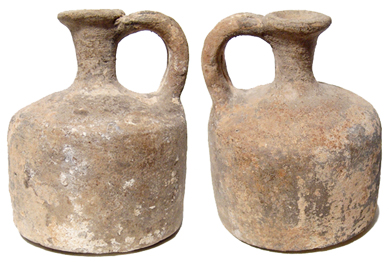 Old Testament-period Holy Land, late Bronze Age, c. 1200-1000 BC. Large creme buff single-handled dipper cup. Nice example with flared lip and raised knob on top of thick handle. Small area where it was burned in antiquity. 140x110 mm (5 1/2" x 4 1/4"). ref: Amirian, R. Ancient Pottery of the Holy Land. Ex-Timeline Galleries, UK. Great big piece! #271020: $325
Old Testament-period Holy Land, late Bronze Age, c. 1200-1000 BC. Large creme buff single-handled dipper cup. Nice example with flared lip and raised knob on top of thick handle. Small area where it was burned in antiquity. 140x110 mm (5 1/2" x 4 1/4"). ref: Amirian, R. Ancient Pottery of the Holy Land. Ex-Timeline Galleries, UK. Great big piece! #271020: $325
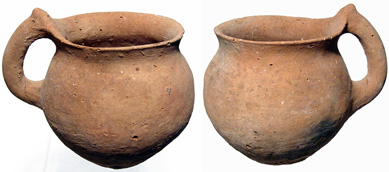 Holy Land. Iron Age, c. 1000 - 600 BC. Shallow terracotta bowl with low ring base and flattened rim. Dia: 4 7/8" (12.4 cm). Intact with age crack and some internal pitting, earthen deposits. Ex Dr. Gilles collection, Germany, acquired prior to 1970. #AH2010: $135
Holy Land. Iron Age, c. 1000 - 600 BC. Shallow terracotta bowl with low ring base and flattened rim. Dia: 4 7/8" (12.4 cm). Intact with age crack and some internal pitting, earthen deposits. Ex Dr. Gilles collection, Germany, acquired prior to 1970. #AH2010: $135
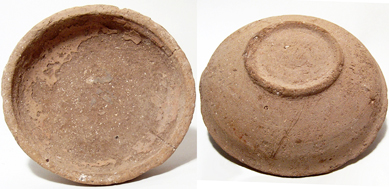 Old Testament-period Holy Land. Bronze Age Judaea, Third Millennium BC. Gorgeous red-ware terracotta single-handled footed cup. Intact with lovely red tone. FOUND IN JERUSALEM! Ex-Hamedian Galleries, Jerusalem. 85 mm (3 1/4") tall. #90915: $299
Old Testament-period Holy Land. Bronze Age Judaea, Third Millennium BC. Gorgeous red-ware terracotta single-handled footed cup. Intact with lovely red tone. FOUND IN JERUSALEM! Ex-Hamedian Galleries, Jerusalem. 85 mm (3 1/4") tall. #90915: $299
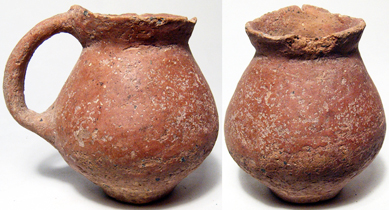 Ancient Holy Land, Judaea. Bronze Age, c. 2000-1500 BC. Small terracotta juglet. Wide body and arched handle comprised of two fused "straps". Some restoration. 84x87 mm (3 1/4 x 3 5/16"). #901269: $199
Ancient Holy Land, Judaea. Bronze Age, c. 2000-1500 BC. Small terracotta juglet. Wide body and arched handle comprised of two fused "straps". Some restoration. 84x87 mm (3 1/4 x 3 5/16"). #901269: $199
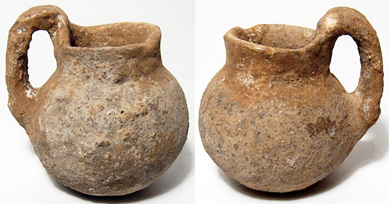 Palestine, Early Bronze Age, c. 3100 - 2900 BC. Nice terracotta amphoriskos, with net pattern painted in red around the bottom portion. Some minor rim chipping. H: 4 1/4" (10.8 cm). A very attractive example of early pottery from the Holy Land! Ex-Hamedian Gallery, Old City, Jerusalem. #861206: $375
Palestine, Early Bronze Age, c. 3100 - 2900 BC. Nice terracotta amphoriskos, with net pattern painted in red around the bottom portion. Some minor rim chipping. H: 4 1/4" (10.8 cm). A very attractive example of early pottery from the Holy Land! Ex-Hamedian Gallery, Old City, Jerusalem. #861206: $375
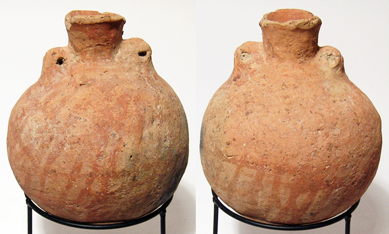 Holy Land, c. 1,000 - 600 BC. Excellent large creme buff terracotta pitcher. Of nice, heavy construction, completely intact but with some minor chipping to rim. Earthen encrustation. 6" (15.2 cm) tall. Ex Midwest collection. Excellent display piece! #0910-141: $599
Holy Land, c. 1,000 - 600 BC. Excellent large creme buff terracotta pitcher. Of nice, heavy construction, completely intact but with some minor chipping to rim. Earthen encrustation. 6" (15.2 cm) tall. Ex Midwest collection. Excellent display piece! #0910-141: $599
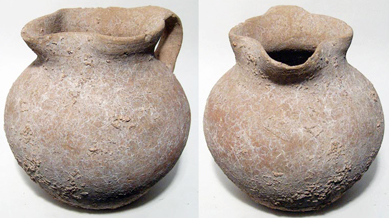
Holy Land, c. 1200 - 800 BC. Beautiful thin-walled terracotta bowl. Made of pink-orange clay body, nicely thrown with angled bottom and small disk base. H: 2" (5.1 cm); Dia: 4 1/2” (11.5 cm). Minor rim chipping, an attractive example! Ex-Hamedian Gallery, Old City, Jerusalem. #861200: $225
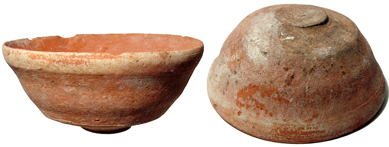 Old Testament-period Holy Land, late Bronze Age, c. 1200-1000 BC. Creme buff single-handled dipper cup. Nice example with flared lip and prominent raised knob on top of thick handle. ref: Amirian, R. Ancient Pottery of the Holy Land. Neat piece! 104x90 mm (4" x 3 78"). Ex-Timeline Galleries, UK. #271022: $299
Old Testament-period Holy Land, late Bronze Age, c. 1200-1000 BC. Creme buff single-handled dipper cup. Nice example with flared lip and prominent raised knob on top of thick handle. ref: Amirian, R. Ancient Pottery of the Holy Land. Neat piece! 104x90 mm (4" x 3 78"). Ex-Timeline Galleries, UK. #271022: $299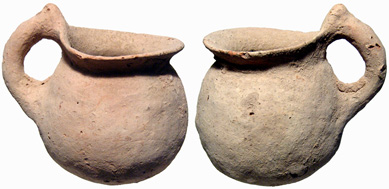
Holy Land, Bronze Age, c. 2000 - 1500 BC. Very nice grey-ware bottle. The body ovoid with small flared foot, the neck very narrow with ridged mouth. Some light restoration to the rim and some pitting and spalling on the surfaces. 110 mm (4 1/4") tall. Ex Donald Simmounds coll., UK. A gorgeous piece! #A12183: $375
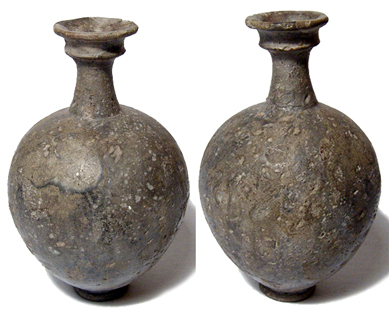 Holy Land. Bronze Age, c. 2000 - 1550 BC. Terracotta juglet. missing the base and repaired from pieces, Heavily encrusted with earthen deposits. H: 2 3/4" (6.9 cm). Ex Dr. Gilles collection, Germany, acquired prior to 1970. An interesting and inexpensive example. #AH2009: $99
Holy Land. Bronze Age, c. 2000 - 1550 BC. Terracotta juglet. missing the base and repaired from pieces, Heavily encrusted with earthen deposits. H: 2 3/4" (6.9 cm). Ex Dr. Gilles collection, Germany, acquired prior to 1970. An interesting and inexpensive example. #AH2009: $99
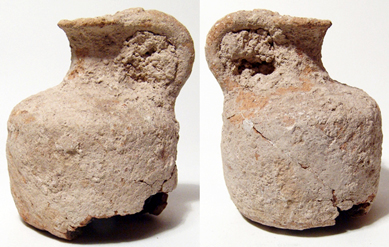 Holy Land. Iron Age, c. 1000 - 600 BC. Nice black-ware juglet. The body rounded with knob on bottom, the neck tubular and lightly flared, single handle at side. H: 4 1/2" (11.4 cm). Handle re-attached, the surfaces with heavy earthen deposits. Doesn't come with stand. Ex Dr. Gilles collection, Germany, acquired prior to 1970. #AH2008: $150
Holy Land. Iron Age, c. 1000 - 600 BC. Nice black-ware juglet. The body rounded with knob on bottom, the neck tubular and lightly flared, single handle at side. H: 4 1/2" (11.4 cm). Handle re-attached, the surfaces with heavy earthen deposits. Doesn't come with stand. Ex Dr. Gilles collection, Germany, acquired prior to 1970. #AH2008: $150
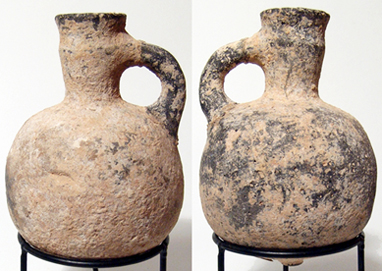 Holy Land, Early Bronze Age, c. 3100 - 2900 BC. Interesting large terracotta amphoriskos, with globular body and tall spout, a small lug handle to either side. H: 6" (15.3 cm). Intact with light earthen encrustation. Ex-Hamedian Gallery, Old City, Jerusalem. #861202: $475
Holy Land, Early Bronze Age, c. 3100 - 2900 BC. Interesting large terracotta amphoriskos, with globular body and tall spout, a small lug handle to either side. H: 6" (15.3 cm). Intact with light earthen encrustation. Ex-Hamedian Gallery, Old City, Jerusalem. #861202: $475
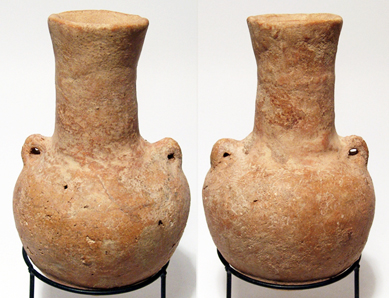 A large and attractive Holy Land red slipped terracotta bowl, 3rd Millennium BC, hand modeled with flat base. Intact with a small raised decorative device on the rim. Nice red slip with some burnishing on the outside. A very nice and well-preserved early terracotta bowl! Could still be used to hold fruit, decorations or other lightweight displayable items in the home! Ex-Touma Dabbah Collection, acquired in the 1960's. #1210166: $350
A large and attractive Holy Land red slipped terracotta bowl, 3rd Millennium BC, hand modeled with flat base. Intact with a small raised decorative device on the rim. Nice red slip with some burnishing on the outside. A very nice and well-preserved early terracotta bowl! Could still be used to hold fruit, decorations or other lightweight displayable items in the home! Ex-Touma Dabbah Collection, acquired in the 1960's. #1210166: $350
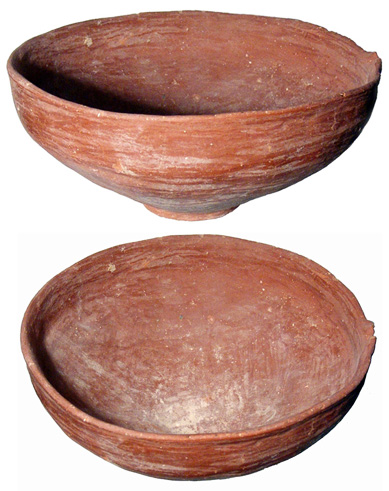 Holy Land, Bronze Age, c. 1500 - 1250 BC. Nice terracotta pyxis, the body squat with vertical sides, short necked with outward turned lip. A thick loop handle to either side. Intact and an attractive form. H: 3 1/2" (8.9 cm). Ex-Hamedian Gallery, Old City, Jerusalem. #861204: $475
Holy Land, Bronze Age, c. 1500 - 1250 BC. Nice terracotta pyxis, the body squat with vertical sides, short necked with outward turned lip. A thick loop handle to either side. Intact and an attractive form. H: 3 1/2" (8.9 cm). Ex-Hamedian Gallery, Old City, Jerusalem. #861204: $475
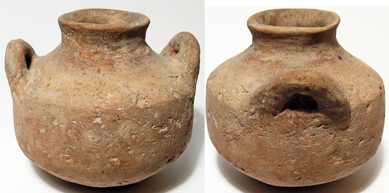 See also: Ancient Roman Terracotta & Pottery Artifacts!
See also: Ancient Roman Terracotta & Pottery Artifacts!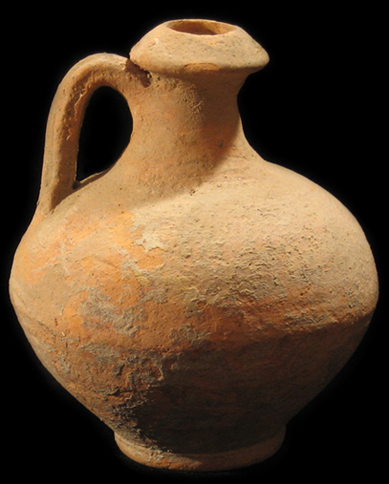 See also: Holy Land Oil Lamps from the time of Moses through Herod the Great and Christ's time in Judaea!
See also: Holy Land Oil Lamps from the time of Moses through Herod the Great and Christ's time in Judaea!
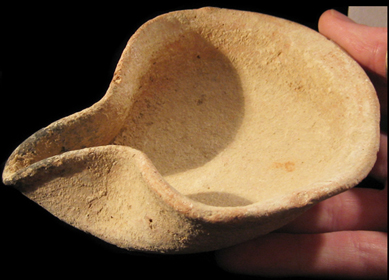
ANCIENT POOLS OF BETHESDA
This is a model of Jerusalem as it appeared in 70 AD. Notice the two pools that made up the Pools of Bethesda. The south and north pools can be seen, along with the five colonnaded porches that surrounded it. Each of the four sides had a colonnaded porch. The fifth colonnaded porch would be the covered dam that separated the two pools.
The area of the Pools of Bethesda has always had a source of water. In the days of the Old Testament, the area was outside the city of Jerusalem to the north. It had a large pool that shepherds used and was called the Sheep Pool. The gate on the north side of Jerusalem was thus called the Sheep Gate. In the 700’s BC a dam was built to turn the spring into a reservoir that would collect rain water which could then be channeled into the city. The area was associated with sheep, sacrifice, and the Temple because of its proximity to the Temple.
The Hasmoneans added a second pool on the south side of the dam and covered the channel to improve water quality. This site was uncovered in 1888 by K. Schick, but it had been known about since the days of the Byzantines and Crusaders, as evidenced by the remains of the church that was built over it. No ancient Jewish writers refer to this pool, although Josephus did write of the Pool of the Sheep-market. Some early Christian writers recorded a spring of water here that flowed with a red, ruddy color that some
people have tried to associate with the blood of the Temple sacrifices. The spring that feeds the pools has been located, and water still collects in the lower areas.
ENGEENIRING BUILDER OF GREAT PALACERuins at a 3,000-year-old fortified city give new insight into the biblical rule of King David, researchers in Israel say.
Archaeologists in Israel say they have found the remains of a 3,000-year-old biblical site, a "suburban palace" from the rule of King David.
Hebrew University in Jerusalem and the Israel Antiquities Authority have been working at the site known as Khirbet Qeiyafa, 20 miles outside of Jerusalem, since 2007. But on Thursday they said they had uncovered the walls of a palace and storeroom that give new insight into the rule of King David.
The structures were part of a fortified city that was ruled from a central authority in Jerusalem and may have been the site of the biblical story of David and Goliath.
"This is indisputable proof of the existence of a central authority in Judah during the time of King David," lead archaeologists Yossi Garfinkel and Saar Ganor said.
But rival researchers dispute Garfinkel and Ganor's research, Haaretz reports, saying that their claims rely too heavily on a literal interpretation of the Bible and that a so-called "United Monarchy" ruled jointly by kings David and Solomon may never have existed at all.
According to the Jerusalem Post, the discovery of the biblical city led the Israel Antiquities Authority to "reject a proposal to build a new neighborhood close to the site, declaring the area and its surroundings a national park."
POTTERY
This is the word that came to Jeremiah from the Lord: “Go down to the potter’s house, and there I will give you my message.” So I went down to the potter’s house, and I saw him working at the wheel. But the pot he was shaping from the clay was marred in his hands; so the potter formed it into another pot, shaping it as seemed best to him.(Jeremiah 18:2-4)
Holy Land, c.1200 – 800 BC. Old Testament-period, late Bronze Age. Nice ceramic single-handle oil dispenser or juglet. The body squat and cylindrical with constricted neck, double-row handle and flared mouth with flattened rim. Intact, minor age cracks on base. 3 3/4". A very interesting vessel. Ex Los Angeles collection. #AH2002: $299
 Old Testament-period Holy Land, late Bronze Age, c. 1200-1000 BC. Large creme buff single-handled dipper cup. Nice example with flared lip and raised knob on top of thick handle. Small area where it was burned in antiquity. 140x110 mm (5 1/2" x 4 1/4"). ref: Amirian, R. Ancient Pottery of the Holy Land. Ex-Timeline Galleries, UK. Great big piece! #271020: $325
Old Testament-period Holy Land, late Bronze Age, c. 1200-1000 BC. Large creme buff single-handled dipper cup. Nice example with flared lip and raised knob on top of thick handle. Small area where it was burned in antiquity. 140x110 mm (5 1/2" x 4 1/4"). ref: Amirian, R. Ancient Pottery of the Holy Land. Ex-Timeline Galleries, UK. Great big piece! #271020: $325 Holy Land. Iron Age, c. 1000 - 600 BC. Shallow terracotta bowl with low ring base and flattened rim. Dia: 4 7/8" (12.4 cm). Intact with age crack and some internal pitting, earthen deposits. Ex Dr. Gilles collection, Germany, acquired prior to 1970. #AH2010: $135
Holy Land. Iron Age, c. 1000 - 600 BC. Shallow terracotta bowl with low ring base and flattened rim. Dia: 4 7/8" (12.4 cm). Intact with age crack and some internal pitting, earthen deposits. Ex Dr. Gilles collection, Germany, acquired prior to 1970. #AH2010: $135 Old Testament-period Holy Land. Bronze Age Judaea, Third Millennium BC. Gorgeous red-ware terracotta single-handled footed cup. Intact with lovely red tone. FOUND IN JERUSALEM! Ex-Hamedian Galleries, Jerusalem. 85 mm (3 1/4") tall. #90915: $299
Old Testament-period Holy Land. Bronze Age Judaea, Third Millennium BC. Gorgeous red-ware terracotta single-handled footed cup. Intact with lovely red tone. FOUND IN JERUSALEM! Ex-Hamedian Galleries, Jerusalem. 85 mm (3 1/4") tall. #90915: $299 Ancient Holy Land, Judaea. Bronze Age, c. 2000-1500 BC. Small terracotta juglet. Wide body and arched handle comprised of two fused "straps". Some restoration. 84x87 mm (3 1/4 x 3 5/16"). #901269: $199
Ancient Holy Land, Judaea. Bronze Age, c. 2000-1500 BC. Small terracotta juglet. Wide body and arched handle comprised of two fused "straps". Some restoration. 84x87 mm (3 1/4 x 3 5/16"). #901269: $199 Palestine, Early Bronze Age, c. 3100 - 2900 BC. Nice terracotta amphoriskos, with net pattern painted in red around the bottom portion. Some minor rim chipping. H: 4 1/4" (10.8 cm). A very attractive example of early pottery from the Holy Land! Ex-Hamedian Gallery, Old City, Jerusalem. #861206: $375
Palestine, Early Bronze Age, c. 3100 - 2900 BC. Nice terracotta amphoriskos, with net pattern painted in red around the bottom portion. Some minor rim chipping. H: 4 1/4" (10.8 cm). A very attractive example of early pottery from the Holy Land! Ex-Hamedian Gallery, Old City, Jerusalem. #861206: $375 Holy Land, c. 1,000 - 600 BC. Excellent large creme buff terracotta pitcher. Of nice, heavy construction, completely intact but with some minor chipping to rim. Earthen encrustation. 6" (15.2 cm) tall. Ex Midwest collection. Excellent display piece! #0910-141: $599
Holy Land, c. 1,000 - 600 BC. Excellent large creme buff terracotta pitcher. Of nice, heavy construction, completely intact but with some minor chipping to rim. Earthen encrustation. 6" (15.2 cm) tall. Ex Midwest collection. Excellent display piece! #0910-141: $599
Holy Land, c. 1200 - 800 BC. Beautiful thin-walled terracotta bowl. Made of pink-orange clay body, nicely thrown with angled bottom and small disk base. H: 2" (5.1 cm); Dia: 4 1/2” (11.5 cm). Minor rim chipping, an attractive example! Ex-Hamedian Gallery, Old City, Jerusalem. #861200: $225
 Old Testament-period Holy Land, late Bronze Age, c. 1200-1000 BC. Creme buff single-handled dipper cup. Nice example with flared lip and prominent raised knob on top of thick handle. ref: Amirian, R. Ancient Pottery of the Holy Land. Neat piece! 104x90 mm (4" x 3 78"). Ex-Timeline Galleries, UK. #271022: $299
Old Testament-period Holy Land, late Bronze Age, c. 1200-1000 BC. Creme buff single-handled dipper cup. Nice example with flared lip and prominent raised knob on top of thick handle. ref: Amirian, R. Ancient Pottery of the Holy Land. Neat piece! 104x90 mm (4" x 3 78"). Ex-Timeline Galleries, UK. #271022: $299
Holy Land, Bronze Age, c. 2000 - 1500 BC. Very nice grey-ware bottle. The body ovoid with small flared foot, the neck very narrow with ridged mouth. Some light restoration to the rim and some pitting and spalling on the surfaces. 110 mm (4 1/4") tall. Ex Donald Simmounds coll., UK. A gorgeous piece! #A12183: $375
 Holy Land. Bronze Age, c. 2000 - 1550 BC. Terracotta juglet. missing the base and repaired from pieces, Heavily encrusted with earthen deposits. H: 2 3/4" (6.9 cm). Ex Dr. Gilles collection, Germany, acquired prior to 1970. An interesting and inexpensive example. #AH2009: $99
Holy Land. Bronze Age, c. 2000 - 1550 BC. Terracotta juglet. missing the base and repaired from pieces, Heavily encrusted with earthen deposits. H: 2 3/4" (6.9 cm). Ex Dr. Gilles collection, Germany, acquired prior to 1970. An interesting and inexpensive example. #AH2009: $99 Holy Land. Iron Age, c. 1000 - 600 BC. Nice black-ware juglet. The body rounded with knob on bottom, the neck tubular and lightly flared, single handle at side. H: 4 1/2" (11.4 cm). Handle re-attached, the surfaces with heavy earthen deposits. Doesn't come with stand. Ex Dr. Gilles collection, Germany, acquired prior to 1970. #AH2008: $150
Holy Land. Iron Age, c. 1000 - 600 BC. Nice black-ware juglet. The body rounded with knob on bottom, the neck tubular and lightly flared, single handle at side. H: 4 1/2" (11.4 cm). Handle re-attached, the surfaces with heavy earthen deposits. Doesn't come with stand. Ex Dr. Gilles collection, Germany, acquired prior to 1970. #AH2008: $150 Holy Land, Early Bronze Age, c. 3100 - 2900 BC. Interesting large terracotta amphoriskos, with globular body and tall spout, a small lug handle to either side. H: 6" (15.3 cm). Intact with light earthen encrustation. Ex-Hamedian Gallery, Old City, Jerusalem. #861202: $475
Holy Land, Early Bronze Age, c. 3100 - 2900 BC. Interesting large terracotta amphoriskos, with globular body and tall spout, a small lug handle to either side. H: 6" (15.3 cm). Intact with light earthen encrustation. Ex-Hamedian Gallery, Old City, Jerusalem. #861202: $475 A large and attractive Holy Land red slipped terracotta bowl, 3rd Millennium BC, hand modeled with flat base. Intact with a small raised decorative device on the rim. Nice red slip with some burnishing on the outside. A very nice and well-preserved early terracotta bowl! Could still be used to hold fruit, decorations or other lightweight displayable items in the home! Ex-Touma Dabbah Collection, acquired in the 1960's. #1210166: $350
A large and attractive Holy Land red slipped terracotta bowl, 3rd Millennium BC, hand modeled with flat base. Intact with a small raised decorative device on the rim. Nice red slip with some burnishing on the outside. A very nice and well-preserved early terracotta bowl! Could still be used to hold fruit, decorations or other lightweight displayable items in the home! Ex-Touma Dabbah Collection, acquired in the 1960's. #1210166: $350 Holy Land, Bronze Age, c. 1500 - 1250 BC. Nice terracotta pyxis, the body squat with vertical sides, short necked with outward turned lip. A thick loop handle to either side. Intact and an attractive form. H: 3 1/2" (8.9 cm). Ex-Hamedian Gallery, Old City, Jerusalem. #861204: $475
Holy Land, Bronze Age, c. 1500 - 1250 BC. Nice terracotta pyxis, the body squat with vertical sides, short necked with outward turned lip. A thick loop handle to either side. Intact and an attractive form. H: 3 1/2" (8.9 cm). Ex-Hamedian Gallery, Old City, Jerusalem. #861204: $475 See also: Ancient Roman Terracotta & Pottery Artifacts!
See also: Ancient Roman Terracotta & Pottery Artifacts! See also: Holy Land Oil Lamps from the time of Moses through Herod the Great and Christ's time in Judaea!
See also: Holy Land Oil Lamps from the time of Moses through Herod the Great and Christ's time in Judaea!
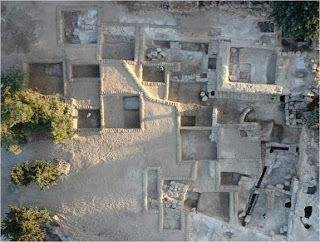



.jpg)
.jpg)


Comments
Post a Comment